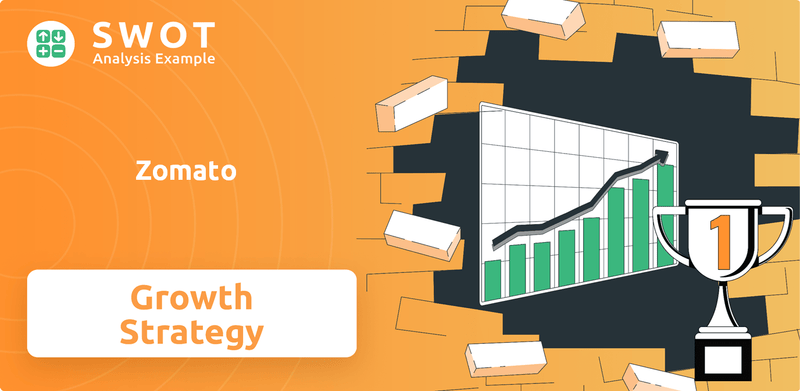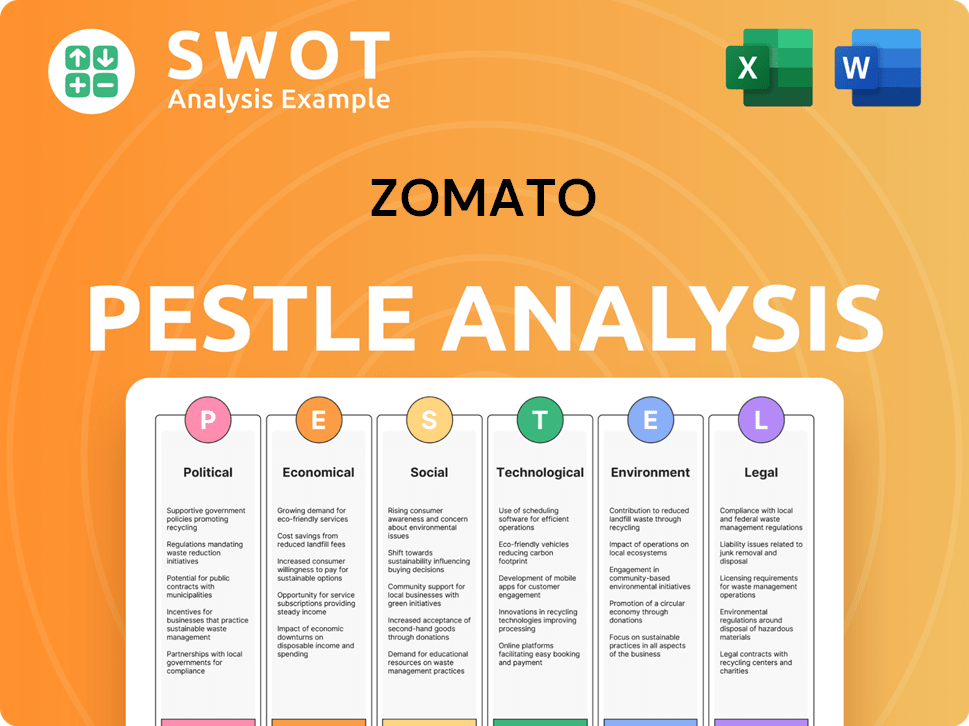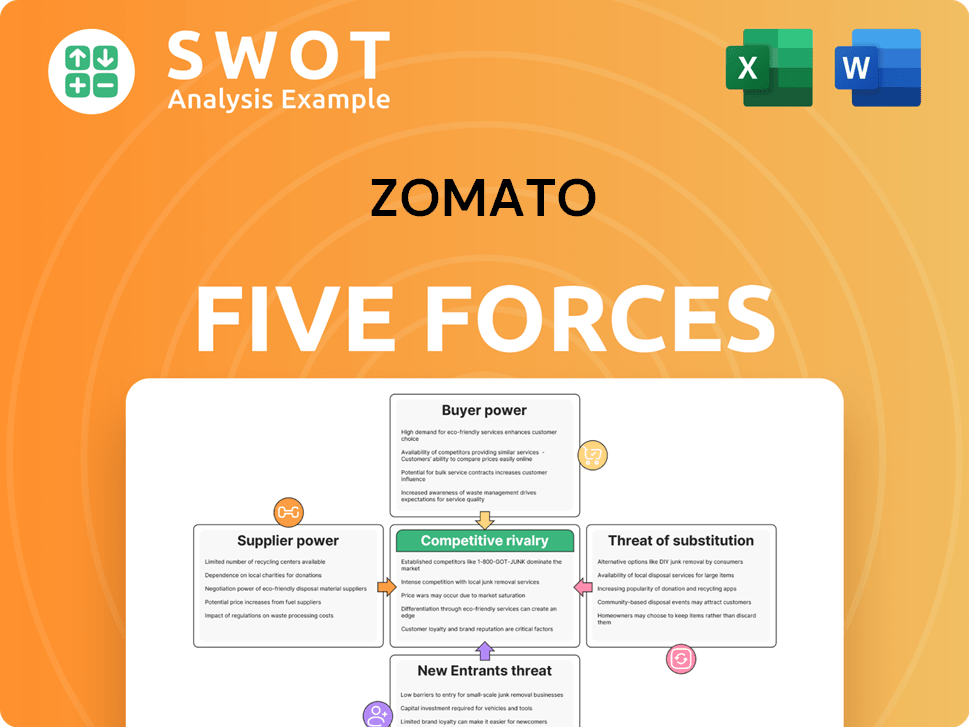Zomato Bundle
Can Zomato Continue Its Culinary Conquest?
Zomato, the food delivery giant, has revolutionized how we experience food. From its humble beginnings as a menu discovery platform, Zomato has rapidly expanded, capturing a significant share of the online food ordering market. This article dives into the Zomato SWOT Analysis to understand its current position and future trajectory.

Explore the dynamic Zomato growth strategy and its ambitious plans for the future. We'll dissect Zomato's future prospects, including its expansion plans in India and internationally, alongside a detailed Zomato company analysis. Discover how Zomato navigates the competitive food delivery market, tackles challenges, and capitalizes on opportunities to maintain its leadership position and drive profitability in the evolving restaurant industry trends.
How Is Zomato Expanding Its Reach?
Zomato's expansion strategy is a multi-pronged approach designed to solidify its position in the food delivery market and diversify its revenue streams. The company is aggressively pursuing both geographical expansion and service diversification to cater to a broader customer base. This strategy is crucial for sustaining its growth trajectory and achieving its long-term objectives in the competitive online food ordering landscape.
The company's primary focus remains on expanding its food delivery business. Zomato aims for a 30% annual growth rate over the next five years. This ambitious target underscores the company's confidence in its ability to capture a larger share of the food delivery market. The expansion plans are supported by strategic initiatives, including increased investment in technology and infrastructure to enhance operational efficiency and customer experience.
A key component of Zomato's growth strategy is the rapid expansion of its quick commerce platform, Blinkit. The acquisition of Blinkit in 2022 has proven to be a strategic move, with the platform experiencing substantial revenue growth. This diversification into quick commerce allows Zomato to capitalize on the increasing demand for instant deliveries, further strengthening its market presence.
Zomato plans to increase its presence from over 500 cities to 1,000 cities by 2025. This expansion will involve entering new markets and increasing its reach within existing ones. The company is focused on increasing its active customer base and restaurant partners. This geographical expansion is a core element of Zomato's food delivery market strategy.
Blinkit is a crucial part of Zomato's expansion plans. The company aims to have 2,000 Blinkit stores by December 2025, a year ahead of its previous target. Blinkit's revenue grew by 129% year-over-year in Q2 FY25, highlighting the platform's rapid growth. This expansion boosts Zomato's overall top-line growth.
Zomato is diversifying its revenue streams beyond food delivery and quick commerce. This includes the B2B supplies arm, Hyperpure, which is growing towards profitability. The company is also enhancing its 'going-out' segment, including restaurant reservations and event ticketing. This diversification aims to reduce reliance on a single revenue source.
In May 2025, Zomato acquired Paytm Insider for Rs 2,048 crore, strengthening its position in the entertainment ticketing business. This acquisition is a strategic move to enhance its offerings and expand its market presence. Strategic acquisitions are a key part of Zomato's overall growth strategy.
Zomato's ability to adapt and innovate is evident in its strategic decisions. While some initiatives, such as the intercity food delivery service 'Legends' and the hyperlocal delivery service 'Xtreme', were discontinued due to a lack of product-market fit, the company continues to explore new avenues for growth. Understanding the Target Market of Zomato is essential for its expansion plans.
Zomato's expansion strategy encompasses geographical growth, diversification of services, and strategic acquisitions. These initiatives are designed to drive revenue growth and improve profitability. The company's focus on quick commerce and its B2B supplies arm are critical for future growth.
- Geographical expansion to 1,000 cities by 2025.
- Aggressive growth of Blinkit, targeting 2,000 stores by December 2025.
- Diversification into B2B supplies and the 'going-out' segment.
- Strategic acquisitions, such as Paytm Insider, to strengthen market position.
Zomato SWOT Analysis
- Complete SWOT Breakdown
- Fully Customizable
- Editable in Excel & Word
- Professional Formatting
- Investor-Ready Format

How Does Zomato Invest in Innovation?
The company heavily relies on technology and innovation to foster growth and enhance the user experience. This strategy includes significant investments in research and development, in-house development, and the adoption of cutting-edge technologies like AI and machine learning. These advancements are crucial for maintaining a competitive edge in the dynamic food delivery market.
A key aspect of the company's technology strategy is its focus on AI-driven personalization and logistics optimization. By utilizing AI and data analytics, the company aims to optimize delivery routes, predict demand, and personalize recommendations for customers, thereby enhancing user experience and operational efficiency. This approach is essential for navigating the complexities of the online food ordering landscape.
The company's commitment to innovation is evident in its strategic initiatives and investments. This commitment is critical for adapting to evolving restaurant industry trends and maintaining a leading position in the market. Further insights into the company's origins can be found in the Brief History of Zomato.
The company uses AI and data analytics to optimize delivery routes and personalize recommendations. This enhances user experience and operational efficiency. This is a core component of the company's Zomato growth strategy.
Significant investments in R&D are made to stay ahead of the curve. In 2024, the company's R&D budget increased by 18%, focusing on AI and machine learning applications.
The company is exploring automation to streamline its services. The introduction of 'Nugget,' an AI-powered customer service platform, showcases this effort. This is a key part of the company's technology and innovation strategy.
Data analytics are used in Hyperpure to optimize inventory management for restaurant partners. This improves efficiency within the B2B supply chain. This is part of the company's Zomato company analysis.
The company is focusing on electric vehicle-based deliveries and optimized logistics. This reduces operational costs and supports sustainability goals. This is important for the company's Zomato future prospects.
Investment in AI-driven logistics improved food delivery times by 25% in 2024. The average delivery time is now approximately 30 minutes.
The company's technology strategy encompasses various initiatives aimed at enhancing user experience and operational efficiency. These advancements are crucial for maintaining a competitive edge in the food delivery market.
- AI-driven personalization and logistics optimization to enhance user experience.
- Integration of machine learning algorithms to improve food recommendation systems. User engagement increased by 15%.
- Introduction of 'Nugget,' an AI-powered customer service platform, in April 2025.
- Focus on electric vehicle-based deliveries and optimized logistics for sustainability.
Zomato PESTLE Analysis
- Covers All 6 PESTLE Categories
- No Research Needed – Save Hours of Work
- Built by Experts, Trusted by Consultants
- Instant Download, Ready to Use
- 100% Editable, Fully Customizable

What Is Zomato’s Growth Forecast?
The financial outlook for Zomato is promising, with significant growth demonstrated in recent years. The company's market capitalization has increased substantially, reaching between Rs 1.95 and Rs 2.2 lakh crore by early 2025. This growth reflects investor confidence and the company's expanding footprint in the food delivery market and related sectors.
In FY24, Zomato reported a total revenue of approximately INR 4,900 crores (around USD 600 million), marking a 50% year-on-year increase. This robust revenue growth underscores the effectiveness of Zomato's growth strategy and its ability to capture a larger share of the online food ordering market. The company's focus on operational efficiency and strategic investments has contributed to its financial performance.
Zomato achieved profitability in FY23 and maintained this positive trend in FY24, reporting profits of INR 351 crore. This profitability is a key indicator of the company's financial health and its ability to generate sustainable earnings. The company's ability to manage costs and optimize its operations has been crucial in achieving and sustaining profitability.
Zomato's revenue grew by 50% year-on-year in FY24, reaching INR 4,900 crores (approximately USD 600 million).
The company reported profits of INR 351 crore in FY24, building on its profitability in FY23.
Zomato's market capitalization is projected to be between Rs 1.95 and Rs 2.2 lakh crore by early 2025.
In Q3 FY25, revenue was Rs 5,405 crore, a 64% increase year-on-year, though net profit decreased due to investments in Blinkit.
In Q3 FY25 (October-December 2024), Zomato's revenue reached Rs 5,405 crore, a 64% increase year-on-year. The net profit for the same period, however, decreased by 57.3% to ₹59 crore, primarily due to increased spending on expanding its quick commerce platform, Blinkit. Despite this, the gross order value (GOV) of its B2C business (quick commerce, food delivery, and going-out) rose by 57% to ₹20,206 crore in Q3 FY25. Blinkit's revenue surged by 129% year-on-year in Q2 FY25, and while it remains loss-making, its losses may reduce as scale and efficiency improve. Zomato aims for steady margin improvement, with food delivery EBITDA margins expected to stabilize at 4-5%. The company's strategic investments and acquisitions, along with its 2021 IPO that raised $1.3 billion, have solidified its financial foundation for continued growth. For a deeper understanding of Zomato's revenue model, consider reading Revenue Streams & Business Model of Zomato.
Food delivery EBITDA margins are expected to stabilize at 4-5%, indicating a focus on profitability within this core segment.
Blinkit's revenue growth is significant, but the platform is still in the investment phase, with losses expected to reduce as it scales.
Subscription income, such as Zomato Gold (now Zomato Pro), accounts for approximately 10% of total earnings and is expected to increase to 15-20% in the near future.
Zomato's strong performance is supported by its substantial market share in the food delivery market, driven by strategic initiatives and customer acquisition strategies.
Analysts have varying forecasts for Zomato's share price in 2025, but the long-term outlook remains positive, supported by industry trends and Zomato's strategic investments.
Zomato's IPO in 2021 raised $1.3 billion, providing a strong financial base for future expansion and investment in technology and market growth.
Zomato Business Model Canvas
- Complete 9-Block Business Model Canvas
- Effortlessly Communicate Your Business Strategy
- Investor-Ready BMC Format
- 100% Editable and Customizable
- Clear and Structured Layout

What Risks Could Slow Zomato’s Growth?
The growth trajectory of Zomato faces several potential risks and obstacles that could impact its strategic objectives. These challenges span competitive pressures, regulatory changes, and operational hurdles, all of which require careful management to ensure sustained expansion and profitability. A thorough Zomato company analysis reveals the complexities inherent in its business model and the external factors that can affect its performance.
Intense competition within the food delivery market is a major concern. Rivals such as Swiggy's Instamart, Zepto, Amazon, and Flipkart are actively vying for market share, especially in the quick commerce segment. This aggressive competition can lead to increased promotional spending and potentially affect Zomato's medium-term profitability. Despite Zomato's strong position in the food delivery sector, with a reported 58% market share, slowing growth in user base and order volumes necessitates strategies to boost revenue, including higher platform fees and increased reliance on advertising and commissions from partners.
Regulatory adjustments and operational inefficiencies also pose significant risks. The company's expansion into new verticals, like fintech, is subject to regulatory scrutiny, while disputes over commission rates with restaurants can create systemic issues. Zomato has also experienced setbacks with new ventures, such as the discontinuation of 'Legends' and 'Xtreme' due to issues with product-market fit and logistical challenges. Furthermore, the high costs associated with establishing dark kitchens for quick commerce initiatives, which can cost around ₹2 crore per kitchen, and the reluctance of food outlets to participate, present additional hurdles. For a deeper understanding, refer to the Marketing Strategy of Zomato.
The food delivery market is highly competitive, with rivals intensifying pressure on Zomato's market share. Increased competition often leads to higher promotional spending to attract and retain customers.
Zomato's expansion into new sectors like fintech is subject to regulatory oversight, which can introduce compliance costs and potential delays. Changes in regulations can directly influence operational strategies.
Maintaining a robust network of delivery partners and controlling escalating operational expenses are continuous challenges. The cost of establishing infrastructure, like dark kitchens, is also a significant factor.
Economic downturns or shifts in consumer behavior can affect order volumes and spending. External factors like inflation can also impact Zomato's profitability.
Managing and retaining a sufficient number of delivery partners and controlling operational costs are ongoing concerns. These internal factors can impact Zomato's ability to scale operations effectively.
Ensuring that new ventures align with market demands is critical. The failure of past initiatives highlights the importance of thorough market analysis and product testing.
The food delivery market is saturated with competitors, including Swiggy, Amazon, and others, driving down prices and profit margins. This intense competition requires Zomato to continuously innovate and refine its operational strategies to maintain its position.
Changes in government regulations regarding commission rates, operational standards, and data privacy can affect Zomato's business model. Compliance with new laws can increase operational costs and require strategic adjustments.
Rising costs associated with delivery personnel, technology, and marketing can squeeze profit margins. Zomato must manage these costs effectively to maintain profitability and sustain growth. The cost of setting up dark kitchens can be substantial, impacting cash flow.
Fluctuations in consumer behavior, such as changes in dining preferences or economic conditions, can impact order volumes and revenue. Staying agile and responsive to market trends is crucial for Zomato's sustained success.
Zomato Porter's Five Forces Analysis
- Covers All 5 Competitive Forces in Detail
- Structured for Consultants, Students, and Founders
- 100% Editable in Microsoft Word & Excel
- Instant Digital Download – Use Immediately
- Compatible with Mac & PC – Fully Unlocked

Related Blogs
- What are Mission Vision & Core Values of Zomato Company?
- What is Competitive Landscape of Zomato Company?
- How Does Zomato Company Work?
- What is Sales and Marketing Strategy of Zomato Company?
- What is Brief History of Zomato Company?
- Who Owns Zomato Company?
- What is Customer Demographics and Target Market of Zomato Company?
Disclaimer
All information, articles, and product details provided on this website are for general informational and educational purposes only. We do not claim any ownership over, nor do we intend to infringe upon, any trademarks, copyrights, logos, brand names, or other intellectual property mentioned or depicted on this site. Such intellectual property remains the property of its respective owners, and any references here are made solely for identification or informational purposes, without implying any affiliation, endorsement, or partnership.
We make no representations or warranties, express or implied, regarding the accuracy, completeness, or suitability of any content or products presented. Nothing on this website should be construed as legal, tax, investment, financial, medical, or other professional advice. In addition, no part of this site—including articles or product references—constitutes a solicitation, recommendation, endorsement, advertisement, or offer to buy or sell any securities, franchises, or other financial instruments, particularly in jurisdictions where such activity would be unlawful.
All content is of a general nature and may not address the specific circumstances of any individual or entity. It is not a substitute for professional advice or services. Any actions you take based on the information provided here are strictly at your own risk. You accept full responsibility for any decisions or outcomes arising from your use of this website and agree to release us from any liability in connection with your use of, or reliance upon, the content or products found herein.